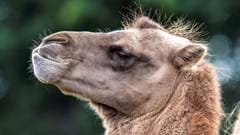Camels
Visit one of the largest herds of Bactrian Camels outside of Asia!
True wild Bactrian Camels evolved independently from other camels, making them a distinct species that is in desperate need of protection. They are only found in the deserts of Mongolia and China and there are thought to be less than a thousand left surviving in this harsh environment.
SPECIES
Much of the Camel population in zoos and wildlife parks across the globe have a domestic Camel influence making them not truly wild.
DID YOU KNOW?
The Wildlife Foundation funded a major conservation project releasing six Bactrian Camels back into the wild. The wild camels had to be taken across inhospitable terrain to a release point over 600 kilometres from their breeding centre near the Mongolia-China border. The journey took up to 15 hours!
BREEDING
Bactrian Camels live in herds of between 6 and 22 individuals with a dominant breeding male.
NUMBERS
Wild Camels are critically endangered in the deserts of Asia due to hunting for meat and their hide, loss of habitat through farming and mining, and loss of their water holes for domestic animal use.
To live in this unforgiving habitat the Wild Bactrian Camel has evolved some remarkable adaptations which you can see by looking at our own Camels. Probably their most noticeable adaptation is their two big humps, which contrary to popular belief do not store water but store fat as a reserve for when food is scarce. As their fat is depleted their humps become floppy.
Another adaptation that you may see (if you visit often enough) is their adaptable fur coat. Because temperatures vary so much in their natural habitat (38°C in the summer and -29°C in the winter) they can grow thick coats in the winter and shed their coats ready for the summer.

What's on today
Sorry, it doesn't look like we have any shows on today.
Nearby? Also look out for…
Subscribe
Get the latest news & offers from Yorkshire Wildlife Park!












